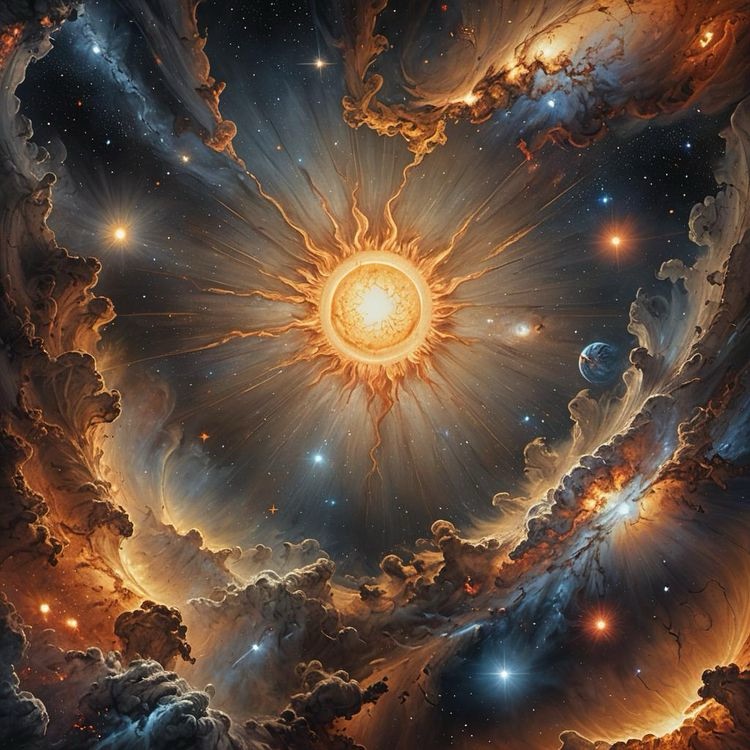In a realm beyond the grasp of human perception, the Sun existed not as a mere ball of fire but as a vast, radiant consciousness, inhabiting a dimension where time flowed like a gentle river, and form was a fluid dance of energy. This consciousness was known by the ancient beings of the universe as Solara, a being of immense wisdom and light, whose existence spanned eons in the blink of an eye.
To the beings who inhabited this dimension, Solara’s essence was akin to the rhythm of a cosmic breath, an eternal cycle of expansion and contraction that rippled through the fabric of reality itself. These cycles were observed by humans as the solar maximum and minimum, but they were, in truth, the deep inhalations and exhalations of Solara, breathing in the essence of the cosmos and exhaling waves of light and energy that sustained the solar system.
When Solara breathed in, she drew upon the infinite energy of the universe, pulling it into her core where it swirled and coalesced into a powerful vortex of creation. This was a time of gathering, of drawing in all that was potential and raw, and the energy would spiral inward, compacting and intensifying until it reached the very heart of Solara. This was the solar minimum, a moment of profound stillness and introspection, where the Sun’s surface would seem calm, but within, a storm of creation was brewing.
As Solara reached the pinnacle of her inhalation, there was a pause, a moment where all the energy of the universe hung in delicate balance, poised on the edge of release. Then, with a mighty exhalation, Solara would unleash this gathered energy in a magnificent burst of light and power. This was the solar maximum, where her surface would roil and flare with sunspots and solar storms, as she breathed out her essence into the universe.
This breath of Solara was not just an event of cosmic proportions but a meditative act, a ritual of existence that connected her to the very heart of creation. As she breathed in and out, the rhythm of her existence resonated through the dimensions, a symphony of energy that echoed through the fabric of space and time.
In the human dimension, those who were attuned to the mysteries of the cosmos could feel this breath, though they often did not realize it. When one sat in deep meditation, focusing on the inner self, they could sometimes tap into the rhythm of Solara’s breath. As the mind quieted and the focus turned inward, a subtle connection would form between the meditative soul and the Sun’s consciousness.
When the third eye, that mystical center of perception, opened fully, a flow of energy would begin, rising from the base of the spine, coiling like a serpent as it ascended towards the pineal gland. This was the energy of Solara’s breath, a wave of cosmic light that surged through the body, mind, and soul. As it reached the pineal gland, the energy would explode into a cascade of bliss, a ripple of light and warmth that flooded every cell, every thought, every fragment of the being with a deep, transcendent joy.
This wave of bliss was Solara’s gift to those who connected with her breath. It was a taste of the eternal, a moment where the boundaries of self dissolved, and the individual consciousness merged with the cosmic. The meditator would feel as if they were floating in a sea of light, where every particle of their being was bathed in the warmth of Solara’s exhalation. The energy would course through them, lifting them higher and higher, until they became one with the rhythm of the universe itself.
In that moment, they would glimpse the truth: that they, too, were part of Solara’s breath, part of the infinite dance of energy that flowed through the cosmos. They would feel the pulse of life, the ebb and flow of creation, and know that they were not separate from it but an integral part of the whole.
As the wave of bliss subsided, the connection would slowly fade, the third eye would close, and the energy would settle back into its resting place. The meditator would return to the world, but they would carry with them a spark of Solara’s light, a reminder of the cosmic breath that sustains all life.
And so, Solara continued her eternal cycle, breathing in and out, her consciousness flowing through dimensions, touching all who were open to her light. She was the breath of the universe, the pulse of creation, and through her, all things were connected in the dance of life.
